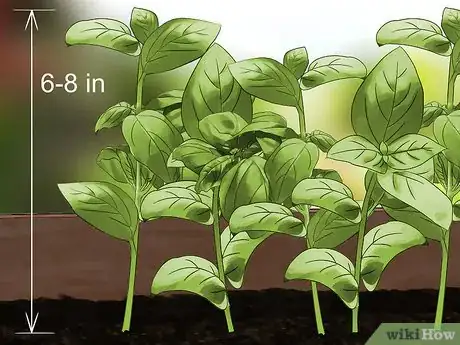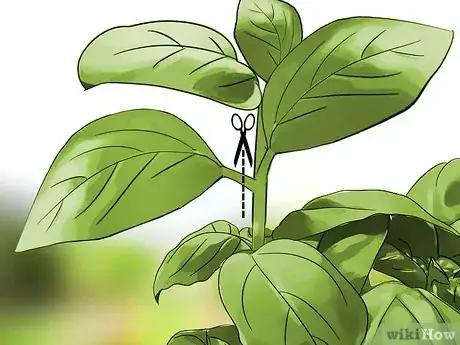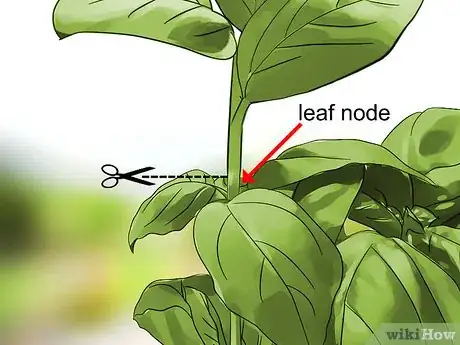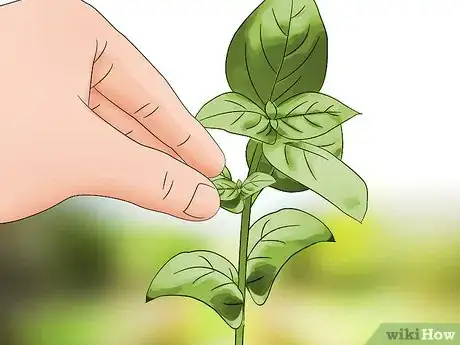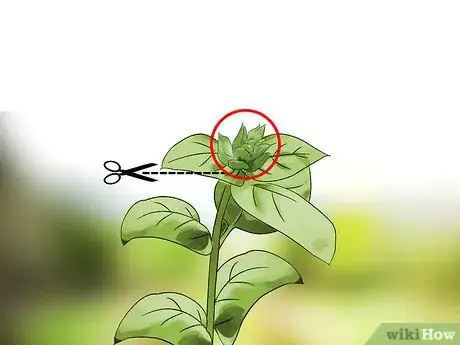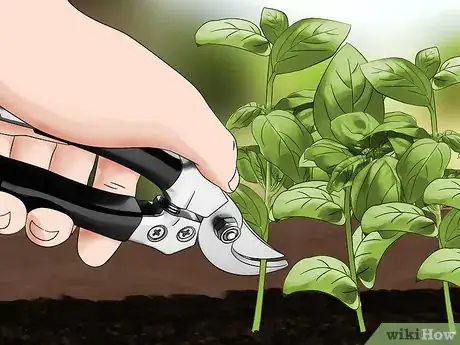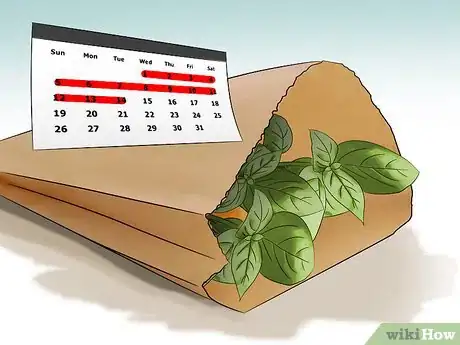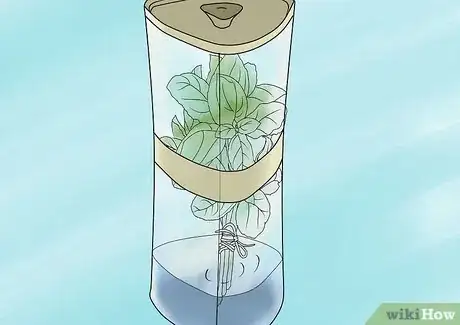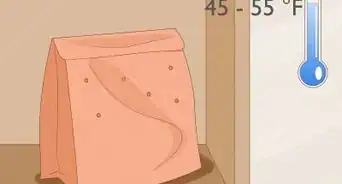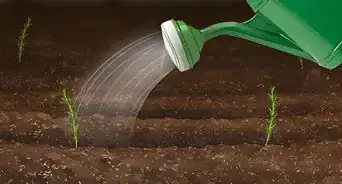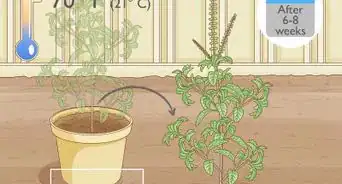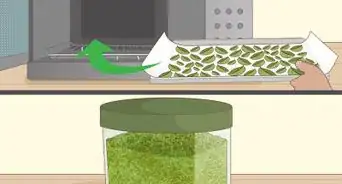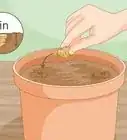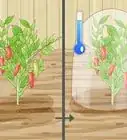This article was co-authored by Artemisia Nursery. Artemisia Nursery is a retail plant nursery in Northeast Los Angeles specializing in California native plants. Artemisia Nursery is a worker-owned small business with plans to become a worker-owned cooperative. In addition to California native plants, Artemisia Nursery offers a selection of succulents, heirloom veggie and herb starts, house plants, pottery, and gardening tools and supplies. Drawing on the knowledge of the founders, Artemisia Nursery also offers consultations, designs, and installations.
There are 11 references cited in this article, which can be found at the bottom of the page.
wikiHow marks an article as reader-approved once it receives enough positive feedback. In this case, 97% of readers who voted found the article helpful, earning it our reader-approved status.
This article has been viewed 335,522 times.
There’s nothing like fresh basil on pizza, pasta, or homemade bruschetta. Not only is harvesting leaves from your basil plant great for your dinner plans, it’s actually also necessary for keeping your plant strong and healthy. We’ll show you the easiest way to harvest fresh basil, plus how to store it so you have delicious basil for weeks or months to come.
Steps
Harvesting Basil Leaves
-
1Harvest leaves once the plant is 6 inches (15 cm) to 8 inches (20 cm) tall. When you water your basil plant, measure it with a tape measure or ruler to see how much it has grown. When the tallest part of the plant reaches 6 inches (15 cm), you can start to harvest its leaves. You should not let your plant exceed 8 inches (20 cm) before trimming it.[1]
-
2Pick off small amounts of leaves whenever you wish. Once your basil plant is grown, you should feel free to pick off leaves whenever you want a fresh garnish. Remove a few leaves from each section of the plant without cutting off any stems. Even this very light harvesting will encourage your basil plant to grow fuller.[2]
- It's best to harvest leaves from the top of the plant, which will lead to bushier, fuller growth. If you harvest the bottom leaves, the plant will grow lanky and thin, and it might not be as healthy or productive.[3]
Advertisement -
3Pinch off basil leaves at the stem. When picking basil leaves, be gentle to avoid tearing them or damaging the stems they are attached to. Pinch basil leaves at their base, where they meet the stem. Gently pull away the entire leaf from the stem.[4]
- You can also cut leaves with a small pair of scissors. Be very careful not to cut the stem while doing so.
Harvesting Stems and Pruning the Plant
-
1Trim the plant from the top down to remove stems. To remove full stems of basil, start from the top and work your way down. This kind of harvesting will remove a greater quantity of the plant so it should begin at the tallest, most full part of the plant, leaving smaller shoots underneath to keep growing. For larger-scale harvesting that you do every few weeks, aim to remove at least one third of the plant’s total height.[5]
- To remove stems easily, use small scissors.
- Harvest the basil when the plant starts to flower, which will encourage new growth.[6]
-
2Cut stems right above the leaf node. When you remove full stems of basil from a plant, always cut as close as possible to the top of the leaf node. Leaf nodes are the points on the plant where side shoots emerge—aim to cut the stems about .25 inches (0.64 cm) above this point. If you leave more than 1 inch (2.5 cm) above the leaf node, the plant will divert nutrients to this stub and away from smaller shoots that need them. This can restrict the overall growth of the plant.[7]
- When you cut just above the node, the plant will divide in two, so it will continue growing in a bushier, fuller form.[8]
-
3Pinch the tips off branches and side shoots. While you are watering it or picking off leaves, take a moment to examine your plant. Use your fingers to gently pinch the tips off of side shoots and branches. This will promote healthy growth and allow your plant to fill out.[9]
-
4Trim away flower buds before they bloom. If you want to keep growing basil, you have to prevent your plant from flowering. Once a basil plant flowers, it will not produce any more leaves. Trim away any buds you see on your plant before they have the chance to blossom. [10]
- If you have harvested enough basil leaves and are ready to see your plant go, allow it to flower and enjoy the beauty.
- Basil flowers are edible but their flavor is stronger than basil leaves and their seed pods are coarse and gritty.[11]
-
5Harvest full, outdoor plants with a hand pruner. If you are growing a large crop of basil plants outdoors and wish to harvest the entire plants, cut them about 3 inches (7.6 cm) above the ground. Use a hand pruner to cut through the entire base of the plant easily. Be sure to shake off the basil plants to remove any bugs and excess dirt.[12]
Storing Harvested Basil
-
1Clean and store fresh basil. After you collect basil, examine it and remove any dead or yellow leaves that you find. Rinse it thoroughly to remove any dirt or debris. Allow it to air dry, or pat it dry with a paper towel. Then, put it in an airtight container like a ziplock bag or plastic storage container.[13]
- The basil can last for up to a few weeks. Just use the leaves or break pieces off as necessary.
-
2Blanch and freeze the leaves. Remove basil leaves from their stem and drop them in a pot of boiling water for five to ten seconds. Remove them with a slotted spoon and transfer them directly to a large bowl with water and ice in it. After several minutes, remove the leaves and lay them out flat to dry on paper towels before storing them in the freezer.[14]
- Place basil leaves in a freezer-safe container or ziplock bag.
- Basil leaves will keep in the freezer for several months.
-
3Dry your basil. Place basil stems in a dry paper bag and place the bag in a warm dry place, such as an attic or kitchen cupboard. Let them dry for one or two weeks, then remove the leaves from the stems. Keep the leaves as intact as possible and store them in canning jars.[15]
- It is best to keep full leaves of dry basil and crumble them at the last minute, if necessary.
- Pull off any yellow or spotted leaves before drying your bail.
- Dried basil should be kept for about a year, or as long as it keeps the same distinct aroma.
- You can also dry basil by hanging it up in bunches in a warm, dry room.[16]
-
4Keep fresh basil in water. Clean stems of basil and trim off their bases. Place them in a glass jar with about 1 inch (2.5 cm) to 2 inches (5.1 cm) of water at the bottom. Basil stems will keep for up to two weeks if they are kept at room temperature and out of direct sunlight.[17]
-
5Make “basil cubes.” In a food processor, add 1 cup (250 ml) of basil leaves and 1 tablespoon (15 ml) of grape seed oil. Process this mixture until the basil leaves are in small bits, then add 1 tablespoon (15 ml) water and process again to make a paste. Pack the mixture tightly into an ice cube tray and freeze it.[18]
- Once the cubes are frozen, transfer them into a freezer-safe container or ziplock bag to store them for easy use.
- You can add basil cubes to sauces, soups, and curries for easy seasoning.
- Basil cubes will keep in the freezer for approximately three to four months.
Expert Q&A
-
QuestionWhat is the best way to pick basil?
 Maggie MoranMaggie Moran is a Professional Gardener in Pennsylvania.
Maggie MoranMaggie Moran is a Professional Gardener in Pennsylvania.
Home & Garden Specialist It is best to just pick a few leaves off of each plant. Simply pinch them off at the stem.
It is best to just pick a few leaves off of each plant. Simply pinch them off at the stem. -
QuestionHow do you harvest basil without killing the plant?
 Maggie MoranMaggie Moran is a Professional Gardener in Pennsylvania.
Maggie MoranMaggie Moran is a Professional Gardener in Pennsylvania.
Home & Garden Specialist Don't pick all the leaves off one plant or cut off the entire stem. Instead, pinch off the small tips to help the plant fill out.
Don't pick all the leaves off one plant or cut off the entire stem. Instead, pinch off the small tips to help the plant fill out. -
QuestionHow do you cut fresh basil?
 Maggie MoranMaggie Moran is a Professional Gardener in Pennsylvania.
Maggie MoranMaggie Moran is a Professional Gardener in Pennsylvania.
Home & Garden Specialist To cut fresh basil, use a sharp knife and cut the leaves as fine as you need to.
To cut fresh basil, use a sharp knife and cut the leaves as fine as you need to.
References
- ↑ https://www.almanac.com/plant/basil
- ↑ https://www.todayshomeowner.com/how-to-harvest-and-use-fresh-basil-from-your-garden/
- ↑ Artemisia Nursery. Plant Nursery & Garden Shop. Expert Interview. 7 August 2020.
- ↑ https://www.almanac.com/plant/basil
- ↑ https://www.todayshomeowner.com/how-to-harvest-and-use-fresh-basil-from-your-garden/
- ↑ Artemisia Nursery. Plant Nursery & Garden Shop. Expert Interview. 7 August 2020.
- ↑ http://www.creeklinehouse.com/2016/05/harvest-basil-strong-productive-plants.html
- ↑ Artemisia Nursery. Plant Nursery & Garden Shop. Expert Interview. 7 August 2020.
- ↑ http://www.grow-it-organically.com/harvesting-basil.html
- ↑ http://www.foodrenegade.com/harvesting-basil-101/
- ↑ http://www.grow-it-organically.com/harvesting-basil.html
- ↑ http://www.grow-it-organically.com/harvesting-basil.html
- ↑ https://www.todayshomeowner.com/how-to-harvest-and-use-fresh-basil-from-your-garden/
- ↑ http://mamaldiane.com/freezing-fresh-basil-whole-leaf/
- ↑ http://www.grow-it-organically.com/harvesting-basil.html
- ↑ https://www.todayshomeowner.com/how-to-harvest-and-use-fresh-basil-from-your-garden/
- ↑ http://www.seriouseats.com/2015/04/the-best-way-to-store-fresh-herbs-parsley-cilantro-dill-basil.html
- ↑ http://www.grow-it-organically.com/harvesting-basil.html
About This Article
To harvest basil, wait until your basil plant is at least 6 inches (15 cm) tall. Then, pinch off any number of leaves with your fingers to use as a garnish or in a recipe. Leave at least half of the leaves on the plant so that it continues to grow. You can also cut the stem 1/4 inch above a leaf if your basil plant is getting taller than you'd like. Peel the individual leaves off of the stem afterward. To harvest the entire plant at the end of the growing season, cut the stem where it meets the soil. Then, pick the individual leaves off of the stem before discarding it. If flower buds appear on your plant at any point, trim them off with a pair of scissors before they bloom. Otherwise, your plant won't grow back after you trim its leaves. For more advice from our Horticulturist reviewer, including how to remove full stems of basil for larger-scale harvesting, keep reading.
